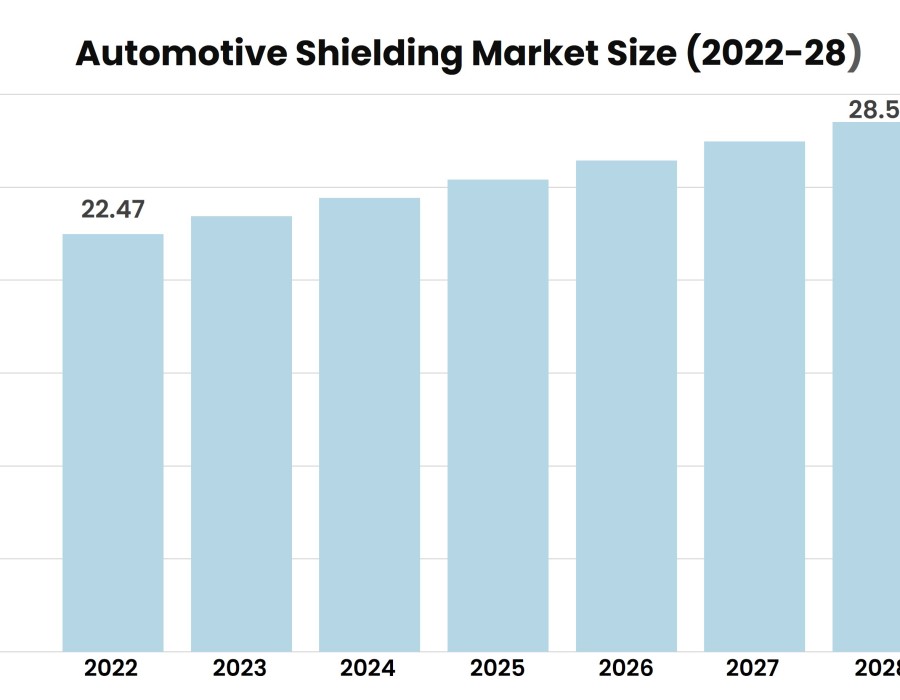According to Stratview Research, the automotive shielding market was estimated at USD 22.47 billion in 2022 and is likely to grow at a CAGR of 3.98% during 2023-2028 to reach USD 28.5 billion in 2028.
Beneath the sleek exteriors and powerful engines of today's vehicles lies a complex world of electronic components, each contributing to the modern driving experience. As automotive technology continues to advance, the rise of Automotive Shielding Technologies emerges as a crucial aspect, ensuring the resilience of these electronics against electromagnetic interference (EMI) and radio-frequency interference (RFI). In this article, we delve into the underappreciated yet essential realm of under-the-hood armor that is reshaping the landscape of automotive engineering.
The Electrification Evolution: With the automotive industry undergoing a transformative shift towards electrification, the density of electronic components under the hood has increased exponentially. Automotive Shielding Technologies rise to the challenge of safeguarding these components from the electromagnetic "noise" that can disrupt their functioning, ensuring the reliability and performance of electric and hybrid vehicles.
Guardians of Connectivity: As vehicles become more connected, with features ranging from advanced infotainment systems to telematics and navigation, the need for effective shielding has never been more critical. Automotive Shielding Technologies act as the guardians of connectivity, preserving the integrity of communication systems and enhancing the overall driving experience.
Materials Revolutionizing Under-the-Hood Armor: The evolution of materials plays a pivotal role in the rise of Automotive Shielding Technologies. Traditional metal shielding has given way to innovative materials such as conductive polymers, metallized fabrics, and lightweight metal alloys. These materials not only provide effective shielding but also contribute to weight reduction and fuel efficiency.
Lightweight Solutions for Performance Enhancement: Automotive engineers face the challenge of balancing the need for effective shielding with the desire for lightweight vehicles that deliver optimal performance. The rise of lightweight shielding solutions addresses this challenge, ensuring that the additional protective measures do not compromise the overall performance and efficiency of the vehicle.
Beyond EMI and RFI: Comprehensive Protection: Automotive Shielding Technologies extend beyond mitigating EMI and RFI. They offer comprehensive protection against environmental factors such as heat, moisture, and vibrations, safeguarding sensitive electronic components from wear and tear. This holistic approach enhances the durability and longevity of under-the-hood electronics.
Advancements in Automotive EMC Solutions: Electromagnetic compatibility (EMC) is a key consideration in the design and implementation of Automotive Shielding Technologies. Advancements in EMC solutions ensure that diverse electronic systems coexist harmoniously, preventing interference that could compromise the functionality of critical components.
Enhancing Safety in Autonomous Vehicles: The advent of autonomous vehicles introduces a new dimension to the importance of Automotive Shielding. As self-driving cars rely on a multitude of sensors, cameras, and communication systems, effective shielding becomes integral to ensuring the safety and reliability of autonomous driving capabilities.
Eco-Friendly Shielding: Sustainability in Under-the-Hood Armor: The automotive industry is increasingly embracing sustainability, and Automotive Shielding Technologies are no exception. Manufacturers are exploring eco-friendly materials and production processes to create shielding solutions that align with the industry's commitment to environmental responsibility.
Integration Challenges and Solutions: Integrating shielding technologies into the complex architecture of modern vehicles poses challenges related to space constraints, thermal management, and overall system integration. Automotive engineers are continuously developing innovative solutions to address these challenges, ensuring seamless integration without compromising performance.
The Road Ahead: Innovation in Motion: As we witness the rise of Automotive Shielding Technologies, the road ahead is paved with innovation. From advancements in materials to breakthroughs in electromagnetic compatibility, the under-the-hood armor is set to evolve continually, shaping a future where vehicles not only drive efficiently but also operate with unprecedented reliability and resilience.
Conclusion:
Under the hood, where technology and tradition converge, Automotive Shielding Technologies stand as silent sentinels, fortifying the electronic heart of modern vehicles. The rise of these technologies signifies a paradigm shift in automotive engineering, ensuring that as vehicles become more sophisticated, they remain resilient to the challenges posed by electromagnetic interference. In this era of electrification, connectivity, and autonomy, under-the-hood armor is not just a necessity—it is the cornerstone of a future where vehicles navigate the roads with enhanced performance, connectivity, and reliability.






Comments